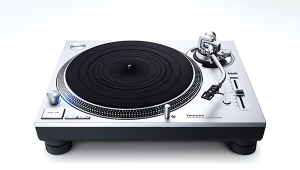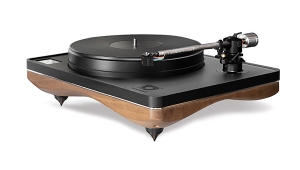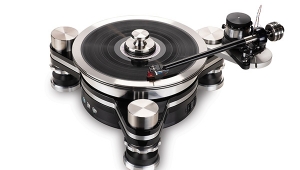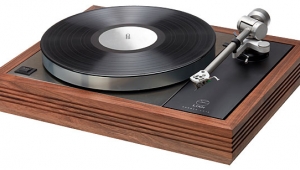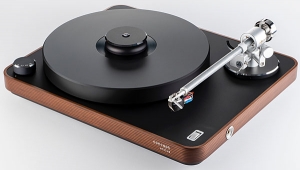| Columns Retired Columns & Blogs |
Hanss Acoustics T-30 turntable
Revolver? More like evolver: 80 years after the first electrically driven record players became available, professional and amateur engineers continue to seek new ways to spin LPs with ever-greater steadiness and precision.
Footnote 1: Apparently, until a few years ago, these basic designs were offered under the Canadian brand name Amari Acoustics.
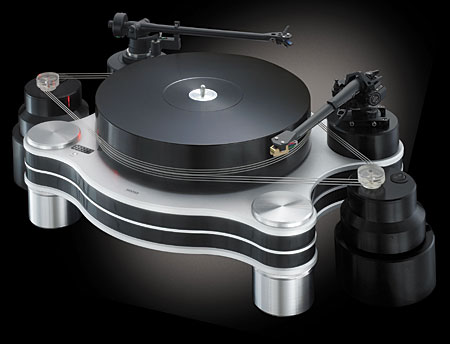
Greater isolation, too: During that time, designers have used a variety of things to keep unwanted vibrations from sullying the marriage of needle and groove, ranging from felt washers and rubber grommets to metal springs to elastic belts to nothing at all. A multinational company called Hanss Acoustics (footnote 1) is among the latest to try their hand at one of the most interesting of these approaches: magnetic opposition, in which record platter and world have no physical contact with one another. And while that isn't the only technical peg on which the Hanss T-30 hangs its hat, I can't help noting that this turntable and its stablemates are among the most affordable realizations of that once-exotic approach—thanks, presumably, to the fact that the outwardly German Hanss products are mostly made in Hong Kong.
Description
The T-30 is more or less the midpoint of the Hanss turntable line. Indeed, their current catalog reflects a modular approach, with successively dearer models sharing the same basic design, yet with more: more motors, more tonearm mounts, more drive belts, more platter mass, more layers of plinth.

To dissipate unwanted vibrations as effectively as possible, the basic Hanss plinth is a sandwich of thin aluminum plates and thick acrylic sheets, bonded together and machined into a shape that, viewed from above, suggests a very large North American blue crab. But the shape is less fanciful than Mies van der Rohe: Three of its five organic-looking pods incorporate Hanss's sturdy support modules—each using an assembly of powerful rare-earth magnets and a rounded metal foot—while the remaining two pods contain the T-30's tonearm supports. Hanss's standard practice is to supply the T-30 with one armboard cut for a Rega RB300 or similar tonearm, and the other cut for an SME arm. The Lotus Group, which distributes Hanss turntables and record cleaners in the US, says they can also supply blank armboards, or ones cut for such alternative tonearms as the Triplanar. The Lotus group's Neil Levy adds that Hanss hasn't yet devised a mounting arrangement for such extra-length arms as the EMT, the Schick, the Shindo, or various others, new and old—but they intend to.
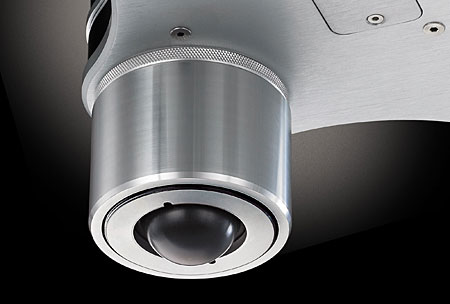
The T-30's feet used opposed magnets to provide an isolating spring action. Similarly, the 2.73"-thick, heavy, black-anodized aluminum platter is supported by an appropriately robust bearing, using magnetic opposition to relieve some but not all of the contact pressure between parts. The bearing's rare-earth magnet probably could do the whole job, but Levy says that a properly adjusted T-30 bearing allows contact between the ceramic lower spindle, stainless-steel thrust ball, and brass bearing well/thrust pad, to achieve the proper degree of mechanical grounding. The inner surface of the height-adjustable bearing well is machined with a spiral groove, presumably to help circulate the relatively light oil within.
Hanss supplies two AC synchronous motors with the T-30, each topped with an acrylic drive pulley and snugged into a multi-tiered aluminum base that's intended to not touch the plinth. The two bases look identical but are of slightly different heights; thus, the three silicone-rubber drive belts powered by the left-hand motor ride the platter a bit higher than the three belts powered by the right-hand motor, for even drive distribution. AC cords from both motors plug into the back of a common outboard power supply, nicely styled to complement the T-30's plinth. In addition to producing clean, stable sinewaves for the motors, the power supply provides a central On/Off switch for both, plus fine-tuning of the selected speed (33.3 or 45rpm, but no 78).
The Hanss T-30 is supplied with a relatively simple, low-mass record clamp, but with no platter mat of any sort, suggesting that intimate contact between vinyl and platter is part of the design—a notion I went along with for all of my listening. Other standard accessories include a plastic strobe disc and, built into the plinth, a battery-powered GRS (generate, rotate, synchronize) optical speed counter. Hanss takes speed stability seriously!
Installation and setup
One sign of a good company is good packing—and the Hanss T-30 had very good packing. Its heavy, generously sized carton was fitted with three layers of sculpted foam, into which the turntable's various parts fit unambiguously well. The installation manual was sparse but sufficient, and literally every step began with the word please. I like that in a manual.
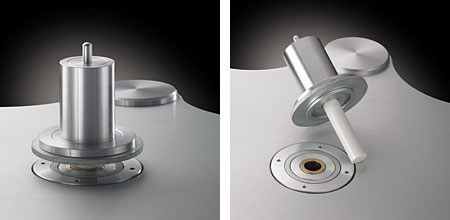
The T-30 requires an open shelf space measuring at least 25" W by 18" D, so I placed it on the top surface of my Box Furniture D3S rack, which also did a fine job of supporting the T-30's 83 lbs. Lowering that heavy plinth into place may have been the only real challenge: Installing the bearing assembly on the plinth took half a minute, including the time it took to open the bearing's plastic pouch. Installing the platter on the bearing consumed another eight or nine seconds of my life. And it took less than five minutes more to scoot the motors into place, plug them into the power supply, and gently stretch the six belts around the platter rim and pulleys.
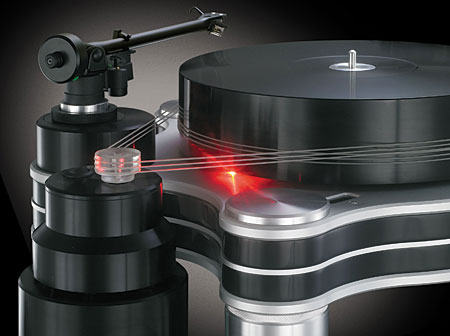
Installing my Rega RB300 tonearm required a bit more work, but even that was notably easier than usual: The T-30's Rega armboard incorporated a fine-pitched height-adjustment mechanism, with twin setscrews for holding the arm pillar neatly and securely in place. (I guessed that a real vinylphile had had a hand in the T-30's design when I saw that they were 2mm setscrews, requiring the same size of hex key that most of us keep on hand for installing phono cartridges.) As delivered, my review sample had the SME armboard in the right-hand position, with the Rega-style armboard off to the back. Swapping them around was the most time-consuming chore presented by the T-30—loosening and tightening the bolts that hold the mounts in place took perhaps 10 minutes—but it was simple enough to do.
Listening
The floor in my listening room is ¾"-thick tongue-and-groove Brazilian cherry over plywood, supported by 2" by 10" joists: I know because I installed the flooring myself. And even though I did the right thing by starting in the middle of the room and working my way out in both directions—done properly, that helps to allow the boards to expand and contract with the seasons—the floor still tends to buckle and bounce a bit in summer.
Footnote 1: Apparently, until a few years ago, these basic designs were offered under the Canadian brand name Amari Acoustics.
- Log in or register to post comments
